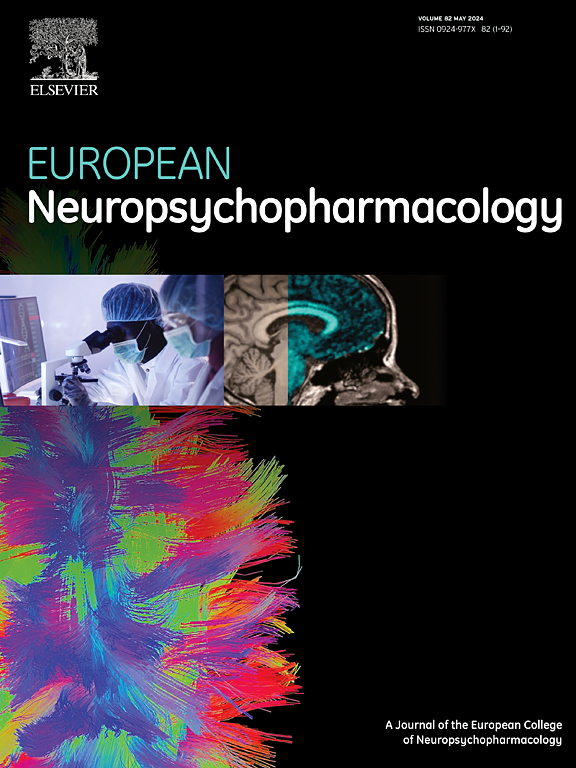GENETICS AND GENOMICS OF ANTIDEPRESSANT ACTION AND RESPONSE
IF 6.7
2区 医学
Q1 CLINICAL NEUROLOGY
引用次数: 0
Abstract
Background
Pharmacological treatment of Major Depressive Disorder (MDD) remains largely empirical with only 27% of patients remitting on first-line medications. These differential responses to antidepressants likely reflect underlying biological heterogeneity in MDD. Here, we investigated MDD heterogeneity through mutually-exclusive groups based on sustained fill of specific antidepressant scripts.
Methods
Using the Australian Genetics of Depression Study (AGDS, 2017-2018) linked to pharmaceutical records (Jul 2013-Dec 2018), we identified mutually exclusive MDD subgroups based on sustained use of a single antidepressant (≥360 cumulative days over 4.5 years) among the 10 most commonly dispensed antidepressants. Among 9,844 participants with self-reported MDD, inferred European ancestry, genotyping, and antidepressant records, we identified 6,106 (62%) with sustained single-antidepressant use without comorbid self-reported bipolar disorder (BIP), 220 (2.2%) with comorbid BIP and ≥4 lithium dispenses (BIP+L group), and 846 (14%) with comorbid BIP but < 4 lithium dispenses (BIP-L group). The reference category for medication class comparisons was the Selective Serotonin Reuptake Inhibitors (SSRIs, N=3,573) group, and for within-class comparisons, it was the SSRI-sertraline (N=1,117) group, as the most common sustained treatments in the AGDS. As a sensitivity analysis, the sustained use threshold was increased to ≥600 cumulative days. To understand innate biological heterogeneity predating depression onset, we investigated associations with 18 polygenic scores (PGS) and reported results passing Bonferroni correction.
Results
The high self-reported treatment response rates among participants after 360+ days of antidepressant use (>90%) support our dispense threshold as a reasonable proxy for treatment acceptability. Compared to the SSRI group, the tetracyclic antidepressant (TeCA-mirtazapine) group (N=177) had higher self-reported suicidal ideation (OR=1.8, 95% CI=1.3-2.6, p=8.7e-4), while the tricyclic antidepressant (TCA-amitriptyline) group (N=151) showed higher rates of physical comorbidities, specifically chronic pain (OR=4.2, CI=2.9-5.9, p=5.3e-15). Reassuringly, the BIP±L groups were strongly associated with BIP PGS (BIP+L: β=0.280 AGDS standard deviation units, SE=0.069, p=5.6e-5; BIP-L: β=0.323, SE=0.038, p=3.5e-17). Under the more stringent sustained use threshold (≥600 days), the duloxetine group (a serotonin norepinephrine reuptake inhibitor, SNRI; N=500) had higher mean body mass index (BMI) PGS (β=0.18, SE= 0.057, p=1.60e-2) and higher self-reported BMI (β=1.35, SE=0.038, p=3.50e-4) compared to the SSRI-sertraline group. After adjustment for BMI PGS, the higher mean self-reported BMI in the duloxetine group was completely eliminated (β=-0.37, SE=0.85, p=0.66), indicating a potential genetic-cardiometabolic influence on SNRI-duloxetine acceptability.
Conclusion
PGS associations with specific antidepressant use may reflect heterogeneous genetic underpinnings of treatment acceptability and inform personalized approaches for MDD. Replication analyses in international cohorts (UKB, Lifelines, and iPSYCH) are underway to determine which signatures reflect robust biological relationships versus artifacts of clinical practice.
抗抑郁药物作用和反应的遗传学和基因组学
背景:重性抑郁障碍(MDD)的药物治疗在很大程度上仍然是经验主义的,只有27%的患者在一线药物治疗后缓解。这些对抗抑郁药物的不同反应可能反映了重度抑郁症潜在的生物学异质性。在这里,我们通过基于持续服用特定抗抑郁药物的互斥组来研究重度抑郁症的异质性。方法使用澳大利亚抑郁症遗传学研究(AGDS, 2017-2018)与药物记录(2013年7月-2018年12月)相关联,我们根据10种最常用的抗抑郁药中持续使用单一抗抑郁药(4.5年累计≥360天)确定了相互排斥的MDD亚组。在9844名自我报告MDD、推断欧洲血统、基因分型和抗抑郁记录的参与者中,我们确定了6106名(62%)持续使用单一抗抑郁药而无合并症自我报告双相情感障碍(BIP), 220名(2.2%)患有合并症BIP和≥4个锂离子配剂(BIP+L组),846名(14%)患有合并症BIP但有4个锂离子配剂(BIP-L组)。药物类别比较的参考类别是选择性5 -羟色胺再摄取抑制剂(SSRIs, N=3,573)组,类别内比较的参考类别是ssri -舍曲林(N=1,117)组,这是AGDS中最常见的持续治疗。作为敏感性分析,持续使用阈值增加到≥600累积天。为了了解抑郁症发病前的先天生物学异质性,我们调查了18个多基因评分(PGS)的相关性,并报告了通过Bonferroni校正的结果。结果参与者在使用抗抑郁药360天后自我报告的治疗反应率较高(>90%),支持我们的分配阈值作为治疗可接受性的合理代理。与SSRI组相比,四环抗抑郁药(teca -米氮平)组(N=177)有更高的自我报告自杀意念(OR=1.8, 95% CI=1.3-2.6, p=8.7e-4),而三环抗抑郁药(tca -阿米替林)组(N=151)有更高的身体合共病发生率,特别是慢性疼痛(OR=4.2, CI=2.9-5.9, p=5.3e-15)。令人放心的是,BIP±L组与BIP PGS有很强的相关性(BIP+L: β=0.280 AGDS标准差单位,SE=0.069, p=5.6e-5; BIP-L: β=0.323, SE=0.038, p=3.5e-17)。在更严格的持续使用阈值(≥600天)下,度洛西汀组(一种5 -羟色胺去甲肾上腺素再摄取抑制剂,SNRI; N=500)的平均体重指数(BMI) PGS (β=0.18, SE= 0.057, p=1.60e-2)和自我报告的BMI (β=1.35, SE=0.038, p=3.50e-4)高于ssri -舍曲林组。调整BMI PGS后,度洛西汀组较高的平均自我报告BMI被完全消除(β=-0.37, SE=0.85, p=0.66),表明遗传-心脏代谢对snri -度洛西汀可接受性的潜在影响。结论pgs与特定抗抑郁药物使用的关联可能反映了治疗可接受性的异质性遗传基础,并为MDD的个性化治疗提供了信息。正在进行国际队列(UKB、lifeline和iPSYCH)的复制分析,以确定哪些特征反映了强大的生物学关系,而不是临床实践的人为影响。
本文章由计算机程序翻译,如有差异,请以英文原文为准。
求助全文
约1分钟内获得全文
求助全文
来源期刊

European Neuropsychopharmacology
医学-精神病学
CiteScore
10.30
自引率
5.40%
发文量
730
审稿时长
41 days
期刊介绍:
European Neuropsychopharmacology is the official publication of the European College of Neuropsychopharmacology (ECNP). In accordance with the mission of the College, the journal focuses on clinical and basic science contributions that advance our understanding of brain function and human behaviour and enable translation into improved treatments and enhanced public health impact in psychiatry. Recent years have been characterized by exciting advances in basic knowledge and available experimental techniques in neuroscience and genomics. However, clinical translation of these findings has not been as rapid. The journal aims to narrow this gap by promoting findings that are expected to have a major impact on both our understanding of the biological bases of mental disorders and the development and improvement of treatments, ideally paving the way for prevention and recovery.
 求助内容:
求助内容: 应助结果提醒方式:
应助结果提醒方式:


